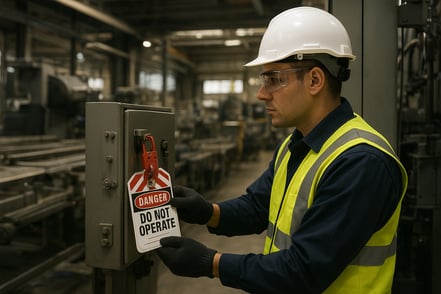Why Oil & Gas Needs a Training Rethink
Few industries operate with higher stakes than Oil & Gas. Every day, workers face flammable materials, extreme pressures, confined spaces, and hazardous chemicals. A single misstep in blowout prevention, lockout/tagout (LOTO), or confined space entry can lead to catastrophic consequences—both human and financial.
Despite strict OSHA and API regulations, traditional safety programs remain challenged: classroom sessions are disengaging, on-site drills are expensive and disruptive, and generic e-learning doesn’t reflect the complex, site-specific environments workers operate in.
The result? Safety lapses persist. According to the U.S. Bureau of Safety and Environmental Enforcement (BSEE), offshore incidents in oil and gas remain a leading cause of injuries and costly downtime. Companies need a better way.
Enter VR Safety Training
Virtual Reality (VR) safety training is transforming how oil and gas firms prepare their workforce. By simulating refinery safety procedures, confined space training, and HAZWOPER protocols in immersive, interactive environments, VR allows workers to practice skills in realistic, risk-free scenarios.
Unlike traditional training, VR enables:
- Repetition without risk – Workers can practice emergency response or valve shut-off procedures as often as needed without exposing themselves to danger.
- Site-specific realism – With platforms like Facilitate’s no-code VR training platform, organizations can rapidly build simulations tailored to their exact rigs, refineries, or pipelines.
- Faster onboarding – Studies show VR training can be up to 4x faster than classroom training while boosting retention to 75–80% one year later.
- Proven incident reduction – Shell reported a 45% reduction in safety incidents after adopting VR training in its operations.
Critical Use Cases in Oil & Gas
- Blowout Prevention & Emergency Response
Trainees can rehearse rapid decision-making during simulated well control events—without risking actual lives or equipment. - Lockout/Tagout Training
Workers practice LOTO procedures in VR before applying them in the field, reinforcing compliance with OSHA 1910.147 standards. - Confined Space Entry
VR scenarios simulate hazardous atmospheres and restricted mobility, giving workers muscle memory for rescue drills and proper PPE usage. - HAZWOPER Training
Hazardous Waste Operations scenarios help teams safely manage chemical spills, leaks, or fires, ensuring adherence to OSHA HAZWOPER requirements. - Refinery Safety Procedures
From heat exchanger maintenance to crane operations, VR replicates high-risk environments so crews can practice safely and repeatedly.
The ROI for Oil & Gas Operators
Investing in VR isn’t just about compliance—it’s about measurable returns:
- Reduced Downtime: Training on digital replicas avoids taking critical equipment offline.
- Fewer Accidents: Preventable incidents decline as workers gain hands-on familiarity before stepping into live environments.
- Lower Training Costs: VR reduces the need for travel, physical materials, and recurring in-person sessions. At scale, VR can be 52% more cost-effective than classroom training.
- Knowledge Retention: Aging experts can codify “tribal knowledge” into VR modules before retiring—ensuring safety practices aren’t lost.
Why Facilitate’s No-Code Platform Matters
Historically, VR training in oil & gas was expensive—requiring specialized developers and long build cycles. Facilitate eliminates these barriers.
With our no-code VR authoring suite, safety managers and subject matter experts can:
- Create refinery-specific simulations in minutes.
- Update content instantly when procedures or equipment change.
- Deploy training across devices—headsets, desktops, or tablets—for maximum accessibility.
This agility is critical in oil & gas, where every site and rig has unique hazards. Facilitate puts the power of VR safety training directly into the hands of those closest to the risk.
Conclusion
From blowouts to lockouts, VR is redefining oil and gas safety training. It enables firms to reduce incidents, accelerate onboarding, and comply with stringent regulations—while protecting their most valuable asset: their workforce.
As the industry continues to navigate rising risks, workforce turnover, and tightening regulations, one thing is clear: the safest training environment is a virtual one.
🚨 Ready to Reduce Safety Incidents in Your Operations?
Facilitate makes it simple to create oil and gas safety training simulations—from blowout prevention to lockout/tagout procedures—without needing developers or long build cycles.
✔️ Build site-specific VR modules in minutes
✔️ Scale training across rigs, refineries, and remote crews
✔️ Prove ROI with measurable reductions in incidents and downtime
👉 Book a demo today and see how Facilitate’s no-code VR platform can make your safety program faster, safer, and more cost-effective.




Comments